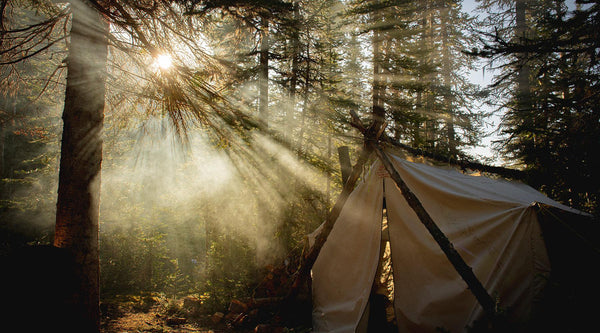What Should Your Hunting Plan Include?
Jul 06, 2021
With draw results coming out for states all around the country, and others just around the corner, hunters all over are gearing up for their upcoming hunts. Deer, elk, sheep, antelope, whatever you may have a tag in your pocket for, there’s always a plan that has to go into preparing for a successful and enjoyable hunt. No one wants to go into a hunt blind. Especially if you’re lucky enough to have drawn a tag with the potential of killing a truly special trophy.
So what should your hunt plan include?
1- Get familiar with the area you're hunting
This one should come first and foremost. Between all the different apps out there from OnX to Google Earth, there’s no reason you shouldn’t be able to get a halfway decent lay of the land and an idea of the terrain of the unit you’re going to hunt. You also will want to look into the amount of private land as opposed to public land.
Nothing can make a hunt more frustrating than fighting the battle of constantly running into private land wherever you go. Set a weekend aside to make a road-trip (if it’s feasible) to go and get some eyes on where you’ll want to go. Talk with some of the locals about certain areas and get together an idea of where some possible prospective areas to hunt will be.
2- Take inventory of the gear you will need
This largely depends on when and where you will be hunting. An early season archery trip in Nevada will require much different gear than a late season rifle trip in Colorado.
I’m not just talking about the clothes you will wear, although that is a large part of it. I’m also talking about the vehicles needed, the things to throw in your pack, and the different components required to keep everything functioning properly.
If you’re hunting in the backcountry of Idaho during the late season rifle hunts, you might want to make sure you have the boots to handle hiking a long ways on the units that require limited ATV access. Or if you’re hunting down in Arizona, you might want to make sure you have the proper optics to ensure you can spot deer from long distances away.
Take into account all other things like rain gear, tents, backpacks, all the way down to the guns and ammunition you intend to use. Being on a hunt with insufficient or low quality gear that will fail can turn a good hunt into a bad one extremely fast. A quick chat with someone that’s been on the same hunt previously can help you prepare, as well as a quick research of the area.
3- SKRE Gear to have on the hill
Your clothing will also play a large and extremely pivotal role in what you take with you as well. For those early season trips, or hunting somewhere where the hunting will be in warmer weather, clothing like the SKRE Gear Kaibab 150 merino wool shirt will serve you well as a main outer layer. The merino wool helps wick moisture, stay cool, and still be wearing a durable piece of clothing.
It’s also a good idea to bring along a vest, like Hardscrabble, or a light jacket like the Lost Peak [now updated to the Grid Lite Jacket], for the lower temperatures in the morning and evenings. That way you’re not left out in the cold, if it does get a little colder, without something to regulate your body temperature.
In the late season hunts, SKRE products like the Ptarmigan 850 Ultra-Down is a fantastic piece of clothing to wear as you sit behind the glasses, trying to glass up your next trophy. Once that trophy is found, you can always layer down to the Hardscrabble jacket to keep you warm as you make your stalk to close the distance.
If there’s rain, the Nebo jacket can also help keep you dry as you work your way into shooting range. It’s also a fantastic idea to use those same Kaibab base layers that you would wear during the early season, underneath all the extra gear. Keeping sweat off you and allowing you to stay comfortable and helping your body regulate its own core temperature. One of the many perks of the Kaibab merino wool systems.
As far as pants go, the Hardscrabble pants can suit almost any and all occasions, but if you’re really looking for something to keep you extra warm come those late, fourth-season hunts, the Kodiak pants are a great option. With an extra layer of micro-fleece insulation, the Kodiak pants are a great option to help you wait out that great buck or bull on those cold late season hunts.
A Great Hunt Starts With A Great Foundation
SKRE Gear® hunting clothing utilizes the many benefits of merino wool and CoreWick2 fabric in their base layer system to set you up for success on your hunts!
Shop Merino Wool Base Layers
4- Call a local biologist or game warden in the area
This will give you the chance to talk about the quality of animals in the unit, where they go, where they can be found, and what to expect for your coming hunt. Hopefully most of this homework had been done before you put in for the hunt, but if not, now it’s really time to lock in and figure out where you can go to kill a quality trophy. Nobody knows that information better than the people who are out on those units day in and day out studying them. A quick phone call to a biologist can land you with some valuable information in regards with what to expect come fall time.
A biologist should be able to tell you the caliber of animals you’ll be chasing, as well as where you’re most likely to find them if you really dig into the conversation. Now, please don’t misunderstand, this shouldn’t take the place of actual scouting, it’s just a good reference point. But it does bring me to my next point-
5- Get out and scout the unit!
If you truly want to be successful, you can’t fly blind. Sure, there’s a few people here and there that get lucky and stumble upon a 380” bull and a 190” buck in a unit they know nothing about. But for every one of those hunters, there’s hundreds of others that didn’t do their homework that either go home empty handed, or leave with a set of antlers or horns that will collect dust in their garage instead of being displayed on a shoulder mount.
There’s no substitute for your own scouting. Set aside a few weekends, make those trips, and figure out where you’re going to have the best chance to kill a quality animal. Once you’re walking up on the trophy of a lifetime, those scouting trips will have made themselves more than worth it. You also can use them as tools to help you prepare for future hunts as well.
Scouting can do anything from telling you which places to hunt, as well as which places to avoid. It can also work as a tool to give you helpful hints as to how to enjoy your hunt off the mountain. From in town dining, to local motels to stay at if you don’t intend to stay on the mountain. So please, for the sake of the hunt, get out and scout!
6- Determine what your hunt strategy will be
A huge part of planning a hunt, is putting together your hunt strategy. Are you going to sit over water? Spot and stalk? Blind? Granted, this can all change on the mountain, but it’s extremely important to have this planned out before the hunt rolls around so you’re not waking up at 4:00 AM on opening morning wondering what you’re going to do.
Some people don’t hunt as meticulously as others. Which is fine. Others put together hunting plans that could rival black ops missions. While these strategies change from day to day and even morning to evening at times, it’s important to get an idea of how exactly you plan to strategize your hunts. That way you’ll know whether or not bring an extra jacket or base layer if you’re going to be sitting still at an ambush site all day, or whether you’ll need to have extra space in the pack to hold the layers as you shed them off when you start hiking for a spot and stalk mission.
7- Become proficient with your weapon
This is an absolutely crucial element to having a successful hunting trip! Nothing is worse than going to all this effort, between making the phone calls, buying the new gear, taking the scouting trips, just to miss when the opportunity presents itself. Whether you’re hunting with a bow, muzzleloader, or rifle, it’s in your best interest to dial that thing in.
First and foremost, figure out what type of shots to expect. The black timber country of Utah will provide closer shots than those of the wide open country of Montana. Figure out what type of shooting you should expect to be doing, then figure out what type of distance you feel comfortable shooting out to, to make a clean, ethical, kill shot, and become “automatic”.
It’s not uncommon for some hunters to do something like push-ups or jumping jacks to get their heart racing, and then take a shot. Just to try to simulate a hunting scenario. Remember, the more realistic the scenario, the better prepared you’ll be.
8- Get in the gym and get in shape
There’s a reason that the guys who are constantly killing all the big deer and all the big bulls are usually backpacking in 10 miles at a time.
1- that’s where the big boys are.
And 2- they’re in good enough shape to do it.
No, this doesn’t mean you need to hire a personal trainer, change your diet, and try to have a washboard stomach by the hunting season (even though your wife or girlfriend might appreciate it). It simply means that you probably should go on some hikes, become good friends with a stair stepper, and get familiar with some altitude before you head out. If the first hiking trip you make is after a big deer, I can promise you it won’t bode well.
In units where the hunting is hard, you have to be willing to hike to the next canyon over, and the next canyon after that. If that’s not something you prepared for, the success of your hunt might be hung up in the lack of planning to get in shape.
9- Set a realistic goal for the caliber of animal you want to shoot
This may obviously differ from area to area and based upon what you see while scouting, but it makes things a lot easier when you decide “Ok, my goal is to shoot a deer that scores at least X amount of inches” before the hunt. That way you know what you’re shooting for, as well as what you’re not shooting for. If you draw a certain tag in New Mexico for elk and decide you want to shoot nothing short of 340” bull, and that’s a realistic task for the unit, there you go.
As long as you have that planned out beforehand, you’ll have a better chance of avoiding the dreaded “ground shrinkage” after waiting so many years to draw your tag. There have been plenty of hunters that have gone out on a hunt wanting to shoot something “good”, and shot something dismal because they got excited and didn’t have a predetermined mark they were holding out for.
When you do set that goal, it makes the hunt all the more rewarding when you hit it, or even exceed it. Just make sure the goal is realistic, attainable, and that you can properly field judge the game you’re hunting to ensure it’s what you’re after.






